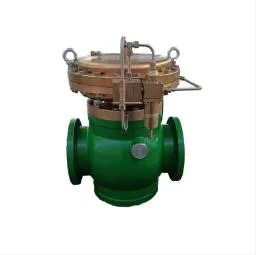
Nov . 29, 2024 16:09
Back to list
The Importance of Pressure Reducing Valves for Safe and Efficient Systems
In any gas or fluid system, maintaining the correct pressure is critical for both safety and performance. Whether you’re working with industrial machinery, residential plumbing, or gas distribution systems, the use of a pressure reducing valve, pressure regulator, or gas regulator can ensure optimal operation and prevent costly damage. In this article, we explore how these essential components work to keep your systems running smoothly and efficiently.

Why a Pressure Reducing Valve is Crucial for System Safety
A pressure reducing valve (PRV) is an essential device in systems that require the regulation of high inlet pressure to a safe and manageable level. These valves are designed to reduce the pressure of incoming fluids or gases to a level that is safe for downstream equipment or processes. Without a pressure reducing valve, high-pressure flow could damage sensitive components, cause leaks, or even lead to catastrophic failures. Whether you're working with water distribution systems or industrial machinery, a pressure reducing valve ensures the safety and longevity of your system by maintaining stable and controlled pressure.
How a Pressure Regulator Ensures Consistent Flow
A pressure regulator is a key component in many systems that require a consistent and steady flow of gas or liquid. Unlike a pressure reducing valve, which primarily reduces pressure to a lower, safe level, a pressure regulator maintains constant pressure within a specific range, regardless of fluctuations in the supply line or system. This ensures that the pressure remains stable, allowing for efficient operation of downstream equipment. For industries that rely on precise pressure control, such as medical, manufacturing, or food processing, a reliable pressure regulator is indispensable for preventing costly downtime and ensuring optimal performance.
The Role of a Gas Regulator in Safe Gas Distribution
For systems that handle gases, such as natural gas, propane, or oxygen, a gas regulator is essential for maintaining safe and efficient operation. A gas regulator controls the pressure of gas as it enters a system, reducing high incoming pressure to a level that is safe for use in appliances, equipment, or machinery. Whether you're working with gas-powered heating systems, cooking appliances, or industrial gas applications, the gas regulator ensures that the correct pressure is delivered, preventing gas leaks, explosions, or system damage. Investing in a high-quality gas regulator is crucial for maintaining safety and compliance with industry standards.
Efficiency and Cost Savings with Pressure Reducing Valves
A well-maintained pressure reducing valve can help you save money in the long run by reducing energy consumption and minimizing wear on equipment. When pressure is too high, systems often consume more energy to function, leading to higher utility bills and unnecessary strain on equipment. By using a pressure reducing valve, you can ensure that your system operates at the most efficient pressure level, reducing energy costs and extending the life of components. This can lead to significant savings in both operational costs and maintenance, making a pressure reducing valve a wise investment for any industrial or residential setup.
Choosing the Right Pressure Regulator and Gas Regulator for Your Needs
Selecting the correct pressure regulator or gas regulator is essential for ensuring that your system operates safely and efficiently. It's important to consider factors such as the type of fluid or gas being regulated, the pressure range required, and the specific needs of your application. A reliable pressure regulator or gas regulator should be durable, accurate, and easy to maintain. Whether you're installing a pressure reducing valve for a water system, a pressure regulator for a compressed air system, or a gas regulator for a residential gas line, choosing the right product will ensure that your system performs optimally and remains safe over time.
In conclusion, whether you're managing an industrial facility, installing a home gas line, or maintaining any system that requires pressure control, a pressure reducing valve, pressure regulator, and gas regulator are crucial for maintaining both safety and efficiency. These components help prevent damage, reduce energy consumption, and ensure that systems operate at peak performance. By choosing high-quality products and keeping them well-maintained, you can extend the life of your equipment, lower operating costs, and ensure smooth, trouble-free operation.
Latest news
-
Safety Valve Spring-Loaded Design Overpressure ProtectionNewsJul.25,2025
-
Precision Voltage Regulator AC5 Accuracy Grade PerformanceNewsJul.25,2025
-
Natural Gas Pressure Regulating Skid Industrial Pipeline ApplicationsNewsJul.25,2025
-
Natural Gas Filter Stainless Steel Mesh Element DesignNewsJul.25,2025
-
Gas Pressure Regulator Valve Direct-Acting Spring-Loaded DesignNewsJul.25,2025
-
Decompression Equipment Multi-Stage Heat Exchange System DesignNewsJul.25,2025

